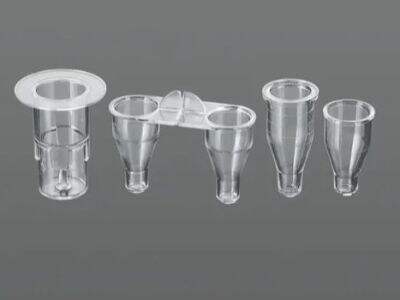Როცა საქმეშია უბრალო ნივთების გადატანა, რომლებიც მiliki ფართო პროცესები მედიცინაში და მეცხრეში, მათი გადატანა არ შეიძლება გაკეთდეს საჭირო ზღვარების გარეშე. ნივთების ყურეები არის მცირე ჩაწერილები, რომლებიც შეიძლება იყოს უბრალო ან არაუბრალო, და იყენებენ ნივთების საშუალების შესაღებად, როგორიცაა სისხლი, ურინი და სლედი. ახლა ბაქტერიები და ნაკლები შეიძლება ჩამოვა ამ ყურეებში, ამიტომ ისინი უნდა დარჩეს sachvenebuli. როდესაც ნივთები იტანებიან, თუ ისინი დაიბადებიან, ეს შეიძლება გავლენა იქონოს არასწორ შედეგებზე, და განსაზღვრული შემთხვევაში პაციენტის დაზღვევაზე. ამიტომ, ძალიან მნიშვნელოვანია როგორ ახალი და იტანებიან ეს ჩივი.

Ნივთის დაცვა: ეს არის ნაბიჯები თქვენი ნივთის საფეხურის დაცვისთვის
Ასე რომ, უბრალო გადატანის საფასური და მრავალფეროვანი საბითები ამ მარტივი და მრავალფეროვანი საბითებით Ნივთის ყურე ბიოქემიური ანალიზატორით .
Აირჩევანი კონტეინერი: სტერილური ნიმუშის გლასები Kangwei Medical-ისგან ხელმისაწვდომია განსხვავებული ზომებით და მასალებით, მაგალითად პლასტმასა, ან სურქმი. აირჩიეთ კონტეინერი, რომელიც საკმარისად დიდია, რათა შეიცავდეს იმ ნიმუშს, რომელიც აგრეთ ახსნათ. ზოგიერთი ნიმუში შეიძლება მოითხოვას უფრო დიდი გლასი, ხოლო სხვები უფრო მცირე. ამიტომ დარწმუნდით, რომ კონტეინერი კარგად დახურულია, რათა ყველაფერი შიგავს დარჩეს. ფორმაში ასევე უნდა იყოს სწორი ინფორმაცია, როგორიცაა pacientის სახელი, ნიმუშის აღების თარიღი და დრო და ტიპი. ეს ინფორმაცია ძალიან მნიშვნელოვანია სწორი იდენტიფიკაციისა და მკვდარის მიღებისთვის.
Ტრანსპორტის კუთხი: აირჩიეთ კუთხი, რომელიც დაცულია სტერილური ნიმუში ურინის ჩვენება რათა აVOID-ის გადასვლა და გადახრა ტრანსპორტირების დროს. კუთხეები ჩვეულებრივ ასეთი სიმძლავრისაა, რომ მათ შეუძლია დახურვა და ხელახლა დახურვა; ასეთი გზით ყველაფერი დარჩება დაცული. ზოგი მათგან შედგება აბსორბირებული ქუჭებით ან ავტომატურად აღიწერს ყველა ჯამის ყველა გერმანის შესახებ სასარგებლო ინფორმაციას. ტრანსპორტის კუთხე ასევე გთავაზობს დამატებით ნადევს, რომ ნიმუშები დარჩება ისე, როგორიც გინდათ.
Დარჩეთ ცილი: ზოგიერთი ნიმუში კარგად იქნება, მაგრამ დახვრებული გახდება, თუ ისინი ინახებიან გამყოფი ტემპერატურაზე ან ქვემოთ. სისხლის ნიმუშები უნდა ინახებიან 2-8°C-ს შორის, რათა წინააღმდეგების გამოწვევა არ ხდეს. დარწმუნდით, რომ წაკითხავთ ინსტრუქციები, რომლებიც მოიყვანენ ნიმუშის კიტით ერთად, ან უბრალოდ გაკითხეთ ჯანმრთელობის სპეციალისტი, როგორ შეძლებთ სწორად შენახავთ ნადежდის COVID-19 ტესტის ნიმუშები. ტრანსპორტირების დროს ნიმუშები შეიძლება ინახონ შესაბამის ტემპერატურაზე ცილის პაკეტების ან გამყოფი კონტენერების გამოყენებით. ეს კი კიდევ უფრო მნიშვნელოვანია, თუ გრძელი პერიოდით გაქვთ გზა.
Აბსოლუტურად არ ახარჯეთ ან აღარ აღწეროთ: თუ ნიმუშები ძალიან ბევრად აღწერენ, ისინი შეიძლება გარდაქმნილი გახდეს. უბრალოდ დაიცვათ ნიმუშები სატრანსპორტო კურთელში და არ შეამოწმეთ ნებისმიერი ახალგაზრდა მოძრაობა. თუ უნდა აიღოთ მეტი ნიმუში, დარწმუნდით, რომ ისინი არიან განსხვავებული მასალებით ან ამჟამად ჩართული მახვილებით შორის, რათა ნიმუშები არ აღწერონ ერთმანეთზე. ტრანსპორტირების წინ ეს იქნება გამოსადეგი ყველა ნიმუშის შენახვისთვის, სადაც ისინი არიან.
Დამოუკიდებლობა სარწმუნო წესებზე: განსაკუთრებით, როცა საქმეში არის ტრანსფერი სტერილური ნაიყავის ჩასახერხებლები მნიშვნელოვანია იმის მიღება, რომ სარწმუნო წესების დამოუკიდებლობა აუცილებელია, რათა დაცული იქნებით გერმანებისგან და ასეთი ფაქტორებისგან. იყენეთ, თუ საჭიროა, რბოლები და მასკები. ეს აუცილებელია თქვენი და სხვათა სარწმუნოდ. მნიშვნელოვანია პროტექტიული საშუალებები ან დაბრუნების შემდეგ ან დაბნელი მასალები სწორედ გასაქმნელ ნაკრებში გადაიტანოთ. სწორი გაქმნა აუცილებელია ინფექციის გავრცელების პრევენციისთვის.
Დარწმუნეთ, რომ თითოეულ ჯერ თქვენ გაქვთ თავისუფალი ნაიყავი
Ასეთი გზით, ისინი უფრო უსაფრთხოდ ტრანსფერირებენ სტერილური ნაიყავის ჩასახერხებლები. მიუხედავად იმისა, რომ თქვენ ხართ ჯანდაცვის სფეროში ან ლაბორატორიის პირობებში. როცა საქმეში არის ეს ჩასახერხებლების ტრანსფერი. მეთოდის სწორი მოძებნა შეიძლება გაუზარდოს ზუსტი შედეგები. ყურადღება და მართვა ნაიყავის ტრანსფერის პროცესში შეიძლება შეიცვალოს შეცდომები, რომლებიც შეიძლება დაზარდნას პაციენტებისთვის. მიმართეთ იმის გახსნა, რომ ნაიყავის მომსახურებით შეიძლება გავლონდეს სხვათა ჯანმრთელობა დასავლეთი მაგრამ დიდი მაგრამით.
Რა უნდა გაკეთოთ სტერილური ნაიყავის ჩასახერხებლების ტრანსფერის წინ
Sterili sample-ის გადატანის შემდეგ, მოიგოთ ეს უკეთეს პრაქტიკის რეკომენდაციები:
Მზადდება: მოძრაობის შემდეგ მასალის გადატანის დროს დარწმუნდით, რომ ყველაფერი ხელს გაქვთ. დარწმუნდით, რომ კონტეინერი დახურულია და ნიშნულია, ასევე უნდა ჰქონდეთ გადატანისთვის ჩამოღების etas, და ნებისმიერი დამატებითი ინსტრუმენტები, რომლებიც შეიძლება გჭირდეთ. ასევე, წაკითხეთ წესები მასალის გადატანისთვის, რადგან ის შეიძლება გადატანილი იყოს გარკვეული გზით ან ცოტა უფრო ყურადღებით.
Დარწმუნდით, რომ მიღების ადამიანს გაძლევთ ნახევარ ინდიკაციას იმის შესახებ, რა უნდა გააკეთოს, როდესაც მიიღებთ მასალას სხვა ადგილზე. უведомეთ მათ, როდის უნდა მიიღონ მასალა, როგორი პირობებით უნდა გადადის ტრანსპორტირების დროს და არის თუ არა სხვა რეგულაციები. თუ შესაძლებელია, გადამისამართების ნომერი, რომელიც გამოსავალია იმის დასამტკიცებლად, რომ მასალა უსაფაროდ მიიღო.
Განიხილეთ შენიშვნები — დაწერეთ ყველაფერი სამაგრამო ტრანსფერის შესახებ: თარიღი, დრო (დაწყება და დასრულება), ტემპერატურის აBNორმალიტეტები, თუ რაიმე შენიშნავთ ამ კონკრეტულ ტრანსფერზე. ეს დოკუმენტაცია შეიძლება გამოიყენოთ მაგიდაში, შემოწმებისა და კითხვებისას ტრანსპორტირების პროცესში. ყველაფერი ჩაწერით, როგორც ის ხდება, გარანტირებს, რომ ამ ინფორმაციას ყოველთვის გაქვთ სამართლებში.
Დააკავშირდით გაგზავნის წესებს: როდესაც მოქმედებთ ზოგიერთი კონკრეტული ნიმუშით, შეიძლება გაქვთ წესები იმის შესახებ, თუ როგორ უნდა გაგზავნოთ ის. ზოგი შეიძლება მოითხოვოს განსაკუთრებულ კარიბულებს ან ნიშნებს. უახლესი რეკომენდაციები და წესების შესახებ კრიტიკულია შეამოწმოთ თქვენს სამუშაო ადგილზე ან ინსტიტუტში, როგორც შესაბამისია. ამ წესების მიხედვით, განსაკუთრებით იქნებით კომპლიანსში და ნიმუშები სწორად იქნება მოქმედებით.
Მონიტორეთ ვარსკვლავის ხარისხი: დარწმუნდით, რომ გამოცდინეთ ვარსკვლავი გადასვლის დროს (ტრეკინგიც შეinges) და რომ ის ჯანმრთელი ჩანს. გამოცდინეთ ტემპერატურა, ქვეყანის დახურვა და ვარსკვლავის ფორმა. ეს ძალიან Gaussian არის, თუ რაღაც ჩანს გადაუზღვავებელი. ეს ასევე მნიშვნელოვანია, რადგან მონიტორингის პირობები დაგვეხმარება პრობლემების გადაღებას, belum ისინი განვითარდებიან დიდ პრობლემად.
 EN
EN
 AR
AR
 BG
BG
 HR
HR
 CS
CS
 DA
DA
 NL
NL
 FI
FI
 FR
FR
 DE
DE
 EL
EL
 HI
HI
 IT
IT
 JA
JA
 KO
KO
 NO
NO
 PL
PL
 PT
PT
 RO
RO
 RU
RU
 ES
ES
 SV
SV
 TL
TL
 ID
ID
 SR
SR
 UK
UK
 VI
VI
 HU
HU
 TH
TH
 TR
TR
 AF
AF
 MS
MS
 BE
BE
 IS
IS
 KA
KA
 BN
BN
 NE
NE
 MY
MY
 KK
KK
 UZ
UZ
